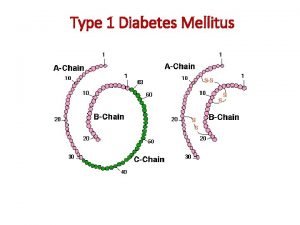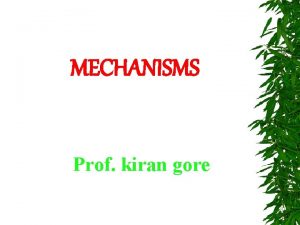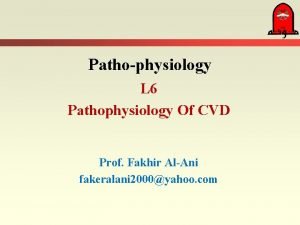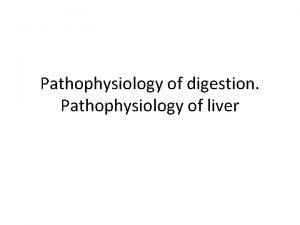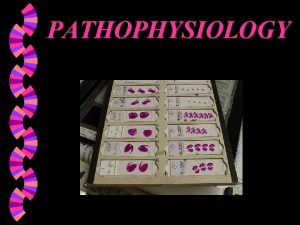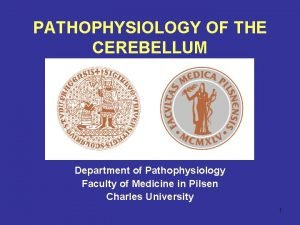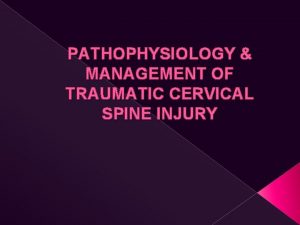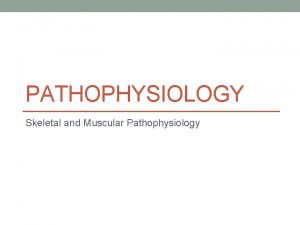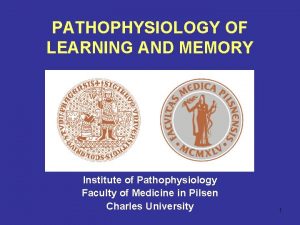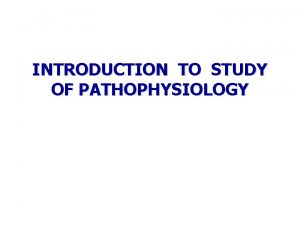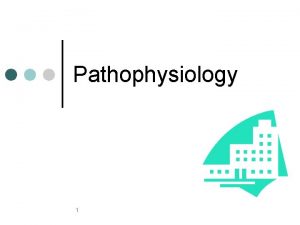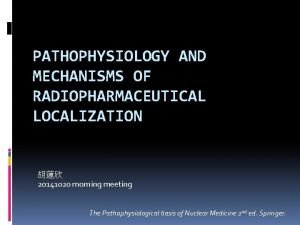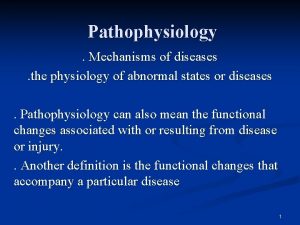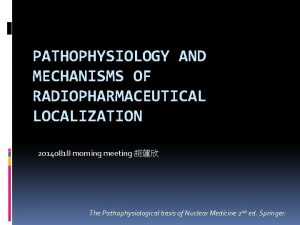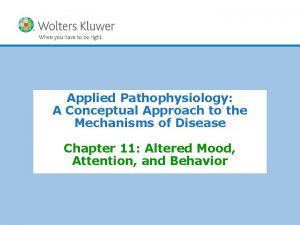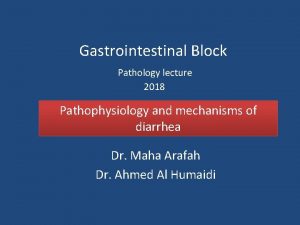PATHOPHYSIOLOGY In Pathophysiology one studies the mechanisms of





















- Slides: 21

PATHOPHYSIOLOGY In Pathophysiology one studies the mechanisms of disease, this introduction material is to present some disease terminology

Terms see page xiii in textbook �Pathophysiology �Is the scientific study of the mechanism of diseases �Pathology � is the investigation of structural changes in cell, tissues and organs that occurs in diseases �Pathogenesis �pattern of development of a disease �Note pathogenesis varies depending on if there is medical intervention or not

Terms �ETIOLOGY �Refers to the cause of a disease �Classification of diseases is often listed by etiology to describe cause of disease �Iatrogenic�condition caused by treatment or diagnostic procedure �Idiopathic�etiology unknown �Nosocomial � hospital acquired infections

Characteristics of diseases �Diseases are characterized by signs and symptoms associated with the disease �Diseases that affect one system more than others can be classified according to the system that is mainly affected, for example �Arthritis is a joint disease, hypertension is a cardiovascular disorder, diabetes mellitus is an endocrine system disease

Clinical magnifications of diseases �SIGNS are indications of diseases �OBJECTIVE MEASUREMENTS � signs are measured by health professional using tools and skills �temperature �pulse �blood pressure �Enlarged heart �Blood glucose levels

SYMPTOMS �SUBJECTIVE INDICATIONS OF DISEASE �Pain- a state of physical, emotional, or mental lack of well- being or physical, emotional, or mental uneasiness that ranges from mild discomfort or dull distress to acute often unbearable agony, may be generalized or localized �fatigue -weariness or exhaustion from labor, exertion, or stress �Aches- to suffer a usually dull persistent pain �Malaise- a vague feeling of weakness or discomfort, often marking the onset of disease

SYNDROME �characteristic combination of signs and symptoms associated with a particular disease �This complex of signs and symptoms usually results from a common cause �example acquired immune deficiency syndrome

Terms related to location and duration of disease �Duration � Acute diseases or conditions- rapid onset and of short duration � example - influenza � Chronic disease- slow onset and of long duration example- arthritis � Remission are periods when symptoms disappear � Exacerbations are periods when symptoms become worse � �Local � local conditions � inflammation around a splinter �Systemic � The whole body is affected or one particular system � fever

note: �some disorders and diseases can have both local and systemic affects. For example a bee sting, causes localized inflammation and systemic affects like increased blood pressure

types of diseases �genetic diseases � infectious ( caused by pathogens) �pathogens- viruses, bacteria, fungi, protozoan � tumors and cancers ( neoplasms ) �physical and chemical agents ( for example UV radiation is a physical agent and lead is a chemical agent � malnutrition �degenerative

Genetic disease classifications �Genetic diseases which are caused by mutations to the first 22 pairs of chromosomes are called autosomal �If the mutation is to the recessive allele than the disease is termed �Autosomal recessive and a person who has the disease has inherited a mutated gene from both the mother and the father �Example- cystic fibrosis �If mutation is to the dominant allele than the disease is termed autosomal dominant �Persons who are AA and Aa both would get the disease �Example would be familial hypercholesterolemia

Genetic disease classifications � X-linked recessive disorders are due to mutations to the X chromosome. A male (Xy) only has to have one mutated allele to have the disease, for a female to get the disease both X chromosomes must carry the mutated form of the gene �Example would be Hemophilia

Examples of different diseases � GENETIC � DISEASES Example would be cystic fibrosis �CONGENITAL Disorders �A defect present at birth � For example fetal alcohol syndrome �ACQUIRED diseases are of many sub-types � INFECTIOUS example tuberculosis � AUTO-IMMUNE example Arthritis � NUTRITIONAL example iron deficiency anemia and pernicious anemia � TRAUMA- head wound � DEGENERATIVE-example Alzheimer’s

Clinical manifestations of diseases �signs and symptoms of disease �medical assessment �diagnosis �therapy �etiologic agent inactivated or symptomatic treatment �analysis of therapy effects �Prognosis� the prospect of survival and recovery from a disease as anticipated from the usual course of that disease or indicated by special features of the case

medical intervention changes disease progression �enhances the bodies capacity for self healing �kills pathogenic agents �treats symptoms of disease or disorder �controls pain �nutritional therapy supplies necessary nutrients

infectious diseases � etiologic agent � pathogen � fungi, bacteria, protozoan, virus � Modes of transmission � Horizontal transmission refers to infectious diseases � Vector- refers to an organism which transmits an infectious organisms trough a bite or sting � The vector for Saint Louis encephalitis is a mosquito � Types of modes of transmission � STD � Example AIDS � Oral/fecal route ( wash your hands, wash your hands) � Hepatitis A � Contaminated water, or food � Salmonellosis from contaminated food � Aerosol (coughing, water droplets) � Tuberculosis � Bites of insects or arachnids � West Nile disease is transmitted by mosquitoes � Rocky Mt. Spotted fever by a bit of a tick

infectious diseases �incubation period �time from exposure to time first signs and symptoms occur �infectious period �time that the sick person can transmit disease pathogens to other persons �disease�illness �recovery or convalescent period �or death

MECHANISMS OF DISEASES cause � Disturbances to homeostasis � Damage to cells � Example- HIV damages the cell membrane when it exits � Damage to tissues � Example-necrosis of the liver � Changes in p. H � Example-diabetes mellitus can cause acidosis � Changes in production of biochemicals � Example in hypercholesterolemia a persons liver makes too much cholesterol � Imbalances in gas, electrolytes, and fluids � Example asthma � Changes in structural components � Example- osteoporosis

Some diseases are classified by they system they affect by subcategories �immune system diseases �Autoimmune �inflammation �allergies �immunodeficiency's �Skeletal system diseases �Bone cancers �Malnourishment diseases- Rickets and osteoporosis �Autoimmune diseases- Rheumatoid arthritis �Trauma- bone fractures �Degenerative- osteoarthritis

Mental diseases �Mental diseases have their own classification system. �It uses the ICD- 10 �www. who. int/entity/classifications/icd/en/bluebook. pdf �This course will not be covering mental diseases �See this document for coding examples �No term papers on mental diseases

Diseases and systems �Sometimes diseases affect one particular system more than others and as such would be treated by specialists who specialize in one body system �For example �Patients with hypertension are treated by either internists or cardiovascular specialists �Patients with diabetes mellitus are treated by internists with a specialty in endocrinology �Patients with arthritis are treated by rheumatologists �Patients with lupus erythmatosis are treated by internists or immunologists
 Diabetes type 1 pathophysiology
Diabetes type 1 pathophysiology Paradigm shift from women studies to gender studies
Paradigm shift from women studies to gender studies One god one empire one emperor
One god one empire one emperor One one one little dogs run
One one one little dogs run One king one law one faith
One king one law one faith Byzantine definition
Byzantine definition One team one plan one goal
One team one plan one goal See one do one teach one
See one do one teach one One price policy
One price policy Night structure
Night structure See one do one teach one
See one do one teach one One vision one identity one community
One vision one identity one community Graphic organizer with the aims of la liga filipina
Graphic organizer with the aims of la liga filipina Hát kết hợp bộ gõ cơ thể
Hát kết hợp bộ gõ cơ thể Slidetodoc
Slidetodoc Bổ thể
Bổ thể Tỉ lệ cơ thể trẻ em
Tỉ lệ cơ thể trẻ em Chó sói
Chó sói Chụp phim tư thế worms-breton
Chụp phim tư thế worms-breton Chúa yêu trần thế
Chúa yêu trần thế Các môn thể thao bắt đầu bằng từ đua
Các môn thể thao bắt đầu bằng từ đua Thế nào là hệ số cao nhất
Thế nào là hệ số cao nhất
